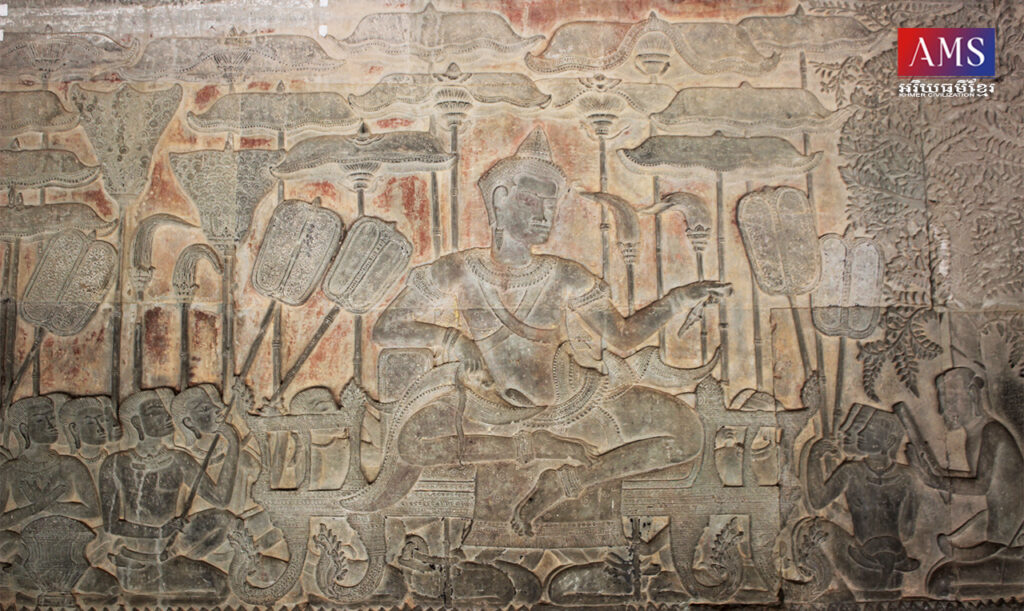ជាការពិតណាស់ មានអ្នកស្រាវជ្រាវ និងអ្នកសិក្សាមួយចំនួននៅតែមានភាពមិនចុះសម្រុងគ្នាលើពាក្យ៣ឃ្លាដែលមានក្នុងសិលាចារឹកសម័យអង្គរមួយចំនួន។ ការសន្និដ្ឋានភាគច្រើនតែងតែភ្ជាប់ពាក្យ២ឃ្លា គឺ វិស្ណុលោក និងពិស្ណុលោក ទៅនឹងឈ្មោះដើមរបស់ប្រាសាទអង្គរវត្ត ទាំងពុំមានសិលាចារឹកមួយណាបញ្ជាក់ឱ្យបានច្បាស់អំពីបញ្ហានេះ។ ម៉្យាងទៀត ក៏មានអ្នកមិនទទួលស្គាល់ថាពាក្យ បរមវិស្ណុលោក គឺជាមរណនាមរបស់ព្រះបាទសូរ្យវរ្ម័នទី២ដែរ។ ដូចនេះ វាគឺជាចំនុចបញ្ហាដែលយើងត្រូវបកស្រាយដោយពឹងផ្អែកលើសិលាចារឹកដែលមានវត្តមានពាក្យទាំងនេះ។
តើឃ្លាទាំង៣មានប្រភពមកពីណា? និងសំដៅទៅលើអ្វីខ្លះ?
ដំបូងយើងត្រូវពិចារណាលើពាក្យ វិស្ណុលោក មុនគេ។ ពាក្យវិស្ណុលោកមានវត្តមានមុនគេក្នុងសិលាចារឹកសតវត្សទី៩ និងទី១០ ហើយពាក្យនេះ គឺសំដៅទៅលើមរណនាមរបស់ព្រះបាទជ័យវរ្ម័នទី៣ (៨៣៦គ.សដល់៨៧៧គ.ស)។ យើងអាចដឹងបានយ៉ាងច្បាស់ថា វិស្ណុលោក គឺជាមរណនាមរបស់ព្រះអង្គតាមរយៈសិលាចារឹកប្រាសាទគោកចក K.521 ដែលបានបញ្ជាក់ថា ព្រះអង្គគឺជារាជបុត្ររបស់ព្រះបាទជ័យវរ្ម័នទី២ (បរមេស្វរៈ)។ យើងអាចដឹងចាប់ពីបន្ទាត់ទី១ដល់ទី៣ ((១)៧៧២ សក គិ នុ វ្រះបាទ ស្រិជៃវរ៌្មទេវ ស្តាច ទៅ វិស្ណុលោក ត រាជបុត្រ (២) វ្រះ បាទ បរមេស្វរ វ្រះ..អិ. វ្រៃ ស្លា អនិន ស្វយ រាជ ឆ្នាំ តប ប្រ(៣)ម្វាយ ចាប តំម្រ្យ ទុក…….)។ ក្រៅពីសិលចារឹកមួយនេះ មានសិលាចារឹកជាច្រើនទៀតដែលបានរំលឹកដល់ព្រះបាទវិស្ណុលោកយាងទៅធ្វើអំណោយ និងប្រគល់ដីធ្លីដល់ទីប្រាសាទនានា។ សិលាចារឹកទាំងនោះមានដូចជា K.175 K.235 K.256 K.449 K.570 K.774 K.826 K.872 K.956 និងK.989។ សិលាចារឹកដែលមានកាលបរិច្ឆេទចុងក្រោយគេ គឺសិលាចារឹកស្តុកកក់ធំ ដែលមានកាលបរិច្ឆេទឆ្នាំ ៩៧៤ស.ក (១០៥២គ.ស)ស្ថិតក្នុងរាជ្យព្រះបាទឧទ័យទិត្យវរ្ម័នទី២ (១០៥០គ.សដល់១០៨០គ.ស) បានរៀបរាបអំពីវង្សត្រកូលរបស់ព្រាហ្មណ៍ម្នាក់ដែលបានបម្រើស្តេច តាំងពីព្រះបាទជ័យវរ្ម័នទី២រហូតដល់ព្រះបាទឧទ័យទិត្យវរ្ម័នទី២។

ពាក្យឬឃ្លាដែលយើងត្រូវពិចារណាបន្ត គឺ បរមវិស្ណុលោក។ ពាក្យនេះយើងឃើញមានតែ២ដងនៅលើផ្ទាំងចម្លាក់ថែវខាងត្បូង ស្លាបខាងលិចរបស់ប្រាសាទអង្គរវត្ត ដែលលោកសឺដេសបានអោយលេខសម្គាល់ K.298។ លោក Aymonier បានសិក្សា និងផ្សាយពីអត្ថបទសិលាចារឹកនេះក្នុងឆ្នាំ១៨៨៣ ហើយរកឃើញសិលាចារឹកខ្លីចំនួន២៨នៅក្បែរចម្លាក់សំខាន់ៗមួយចំនួន។ នៅលើផ្ទាំងចម្លាក់បង្ហាញពីក្សត្រមួយអង្គដែលគេគិតថាជាព្រះបាទសូរ្យវរ្ម័នទី២នៅវ័យជំទង់ មានផ្ទាំងសិលាចារឹកមួយបន្ទាត់ (K.298-2) និយាយអំពីសកម្មភាពនៃការត្រួតនិងបញ្ចុះពលរបស់ព្រះអង្គនៅលើភ្នំសិវបាទ សម្តច វ្រះ បាទ កម្រតេង អញ បរមវិស្ណុលោក នា ស្តច នៅ វ្នំ ឝិវបាទ បិ បញ្ចុះ វល ប៉ុន្តែអ្វីដែលចម្លែកនោះគឺគេបានប្រើឈ្មោះជាមរណនាមរបស់ព្រះអង្គទៅវិញ។
សិលាចារឹក១ទៀត គឺស្ថិតនៅក្បែរជើងរបស់ព្រះបាទសូរ្យវរ្ម័នទី២ ពេលព្រះអង្គទ្រង់ឈរលើខ្នងដំរីដើម្បីចូលរួមចំបាំង (K.298-17) ហើយសិលាចារឹកនេះបញ្ជាក់យ៉ាងច្បាស់ថា ផ្ទាំងចម្លាក់នេះគឺជាព្រះបាទសូរ្យវរ្ម័នទី២ វ្រះ បាទ កម្រតេង អញ បរម វិស្ណុលោក ។ ក្រៅពីសិលាចារឹក២នេះ យើងពុំមានសិលាចារឹកណាបង្ហាញពីពាក្យ បរមវិស្ណុលោក ទេ។ មានសិលាចារឹកមួយចំនួនដែលបង្ហាញពីព្រះនាមរបស់ព្រះអង្គពេលនៅមានព្រះជន្ម ដូចជាសិលាចារឹក K.200 K.254 K.273 K.287 K.288 K.547 K.597 K.908 K.347 K.364 K.366 K.383 K.384 K.523 K.524 K.685 K.692 K.736 និងK.791 ជាដើម។ ដោយសារពុំមានសិលាចារឹកណាមួយបញ្ជាក់ពីទំនាក់ទំនងនៃពាក្យ បរមវិស្ណុលោក ថាជាមរណនាមរបស់ព្រះសូរ្យវរ៌្មទេវ (សូរ្យវរ្ម័ន) ទើបបានជាមានអ្នកស្រាវជ្រាវមួយចំនួននៅមិនទាន់ឯកភាពថា បរមវិស្ណុលោក គឺជាមរណនាមរបស់ព្រះបាទសូរ្យវរ្ម័នទី២។ ផ្ទុយពីនេះ តាមសិលាចារឹកខ្លីទាំង២ ដែលគេបានចារនៅក្បែរចម្លាក់ទាំង២របស់ក្សត្រ១អង្គនេះ និងប្រៀបធៀបនិងសកម្មភាពមួយចំនួនក្នុងសិលាចារឹកដទៃ ពិសេសគឺសកម្មភាពធ្វើចម្បាំងជាមួយប្រទេសចម្ប៉ា និងដៃវៀត ដែលគេបានសិក្សាតាមរបាយការណ៍របស់ដៃវៀត ធ្វើអោយអ្នកស្រាវជ្រាវមួយចំនួនធំគិតថាចម្លាក់ទាំង២នោះគឺជារូបព្រះបាទសូរ្យវរ្ម័នទី២ ដែលមានមរណនាមហៅថា បរមវិស្ណុលោក។

ចំនុចចុងក្រោយគឺពាក្យ ពិស្ណុលោក ដែលមានបង្ហាញក្នុងសិលាចារឹកមួយចំនួនក្នុងសម័យក្រោយអង្គរ។ សិលាចារឹកដែលមានឈ្មោះពិស្ណុលោកនេះ គឺចារនៅតាមជញ្ជាំង និងសសររបស់ប្រាសាទអង្គរវត្ត មានកាលបរិច្ឆេទចន្លោះពីឆ្នាំ១៥៧៧គ.សដល់ឆ្នាំ១៦៣២គ.ស មានដូចជា៖ IMA 2 (1577) IMA 3A (1579) IMA 6A (1599) IMA 8 (1626) IMA 12 (1629) IMA 16b (1632) និងIMA 17 (1632)។ សិលាចារឹកទាំងអស់នេះតែងបង្ហាញ និងបញ្ជាក់ថា ពាក្យ ពិស្ណុលោក គឺជាឈ្មោះរបស់ប្រាសាទអង្គរវត្ត ដែលជាទីឋានប្រជុំនូវទេពទាំងឡាយ។
ជាសង្ខេប យើងឃើញថាពាក្យឬឃ្លាទាំង៣នេះមានអត្ថន័យផ្សេងគ្នា។ ពាក្យ វិស្ណុលោក គឺជាមរណនាមរបស់ព្រះបាទជ័យវរ្ម័នទី៣ ដែលមានបង្ហាញក្នុងសិលាចារឹកសតវត្សទី៩ដល់សតវត្សទី១១។ ពាក្យ បរមវិស្ណុលោក គឺជាមរណនាមរបស់ព្រះបាទសូរ្យវរ្ម័នទី២ ដែលមានបង្ហាញតែ២ដងនៅលើផ្ទាំងចម្លាក់ថែវខាងត្បូង ស្លាបខាងលិចរបស់ប្រាសាទអង្គរវត្ត។ ចំណែកពាក្យ ពិស្ណុលោក គឺជាពាក្យថ្មីក្រោយពីការស្ថាបនាប្រាសាទអង្គរវត្តប្រហែល៤០០ឆ្នាំ គឺពីសតវត្សទី១៦ដល់១៧។ សិលាចារឹកទាំងនោះតែងសំដៅថា ប្រាសាទអង្គរវត្តមានឈ្មោះ ពិស្ណុលោក។
——————————————————
The word Vishnuloka, Parama Vishnuloka and Bishnuloka
There are three words in the Angkorian inscriptions that raise some arguments between the scholars. Accordingly, two words are more likely to be addressed and indicated to the ancient name of Angkor Wat temple, Vishnuloka, and Bishnuloka. Also, some scholars do not agree that Parama Vishnuloka was the posthumous name of King Suryavarman II. What are the source and meaning of these three words?
Firstly, the word Vishnuloka appears in the inscriptions of the 9th and 10th centuries. It refers to the posthumous name of King Jayavarman III (836 CE-877 CE), in Kok Chak inscription K.521, lines 1-3. Besides, there are many inscriptions that describe the donation acts of the King name Vishnuloka. Those inscriptions are K.175, K.235, K.256, K.449, K.570, K.774, K.826, K.872, K.956, and K.989. Among them, the Sdok Kak Thom inscription has the latest date, 974 Çaka or 1051 CE.
Secondly, the word Parama Vishunuloka appears on the southern wall of the gallery of Angkor Wat temple and it has inventory number K.298. It was studying by Aymonier and published in 1883 together with other 28 short inscriptions nearby. On the bas-relief shows a teenage King and the short inscription near there says Samdac Vraḥ Pāda Karateṅ Añ Parama Vishunuloka Nā Stac Nov Vnaṃ Shivapada Pi Panchuh Bala (The King Parama Vishuloka manages the armies on Shivapada mountain). Interesting, he is shown with a posthumous name. The second inscription was written near the foot of King Suryavarman II when he stood on the elephant for the battle. The inscription shows the name of the King as Vraḥ Pāda Karateṅ Añ Parama Vishnuloka. There are some inscriptions that show the name of the King when he was still alive. They are K.200, 254, 273, 287, 288, 547, 597, 908, 347, 364, 366, 383, 384, 523, 524, 685, 692, 736, and 791. Remarkably, due to there is no information about the relations of the word Parama Vishnuloka to the posthumous name of King Suryvarman II, the scholars are in question in this information.
Thirdly, the word Bishnuloka appears in some inscriptions after the Angkorian period. The inscriptions that have the word Bishnuloka were written on the walls and the columns of Angkor Wat temple, dating from 1577 CE to 1632 CE. Those inscriptions are Inscription Modern Angkor (IMA) 2, 3A, 6A, 8, 12, 16b and 17. Those inscriptions indicate the word Bishnuloka as the name of Angkor Wat temple.
In conclusion, the three words, Vishnuloka, Parama Vishnuloka, and Bishnuloka have the same meaning. Vishnuloka was the posthumous name of King Jayavarman III based on the inscriptions from the 9th to 11th century. Parama Vishnuloka was the posthumous name of King Suryavarman II based on the two inscriptions on the wall of the southern gallery of Angkor Wat temple. Furthermore, Bishnuloka was the name of Angkor Wat that gave after the construction of Angkor Wat temple about 400 years (16th to 17th century).
អត្ថបទដោយ៖ លោក សុខ កែវ សុវណ្ណារ៉ា






